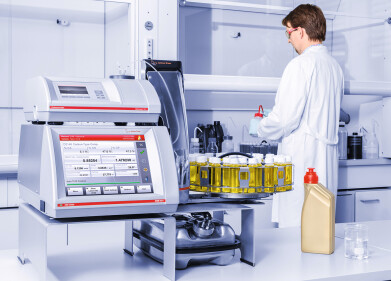Measurement and Testing
The US DOT issues Emergency Testing Order for Transport of Crude Oils
Mar 19 2014
The US Department of Transportation (DOT) has issued an Emergency Testing Order that requires all shippers to test crude oil from the Bakken region to ensure the proper identification of the crude oil before it is transported by rail. The Emergency Testing Order is in response to a number of recent incidents involving the derailment of trains transporting crude oil from Canada to the United States.
Shippers are required to comply with Hazardous Materials Regulations (HMR) that include testing of vapor pressure and flashpoint to ensure proper transportation and packing. To meet these regulations, Vienna-based vapor pressure specialist AMETEK Grabner Instruments offers specialized instrumentation to test crude oil vapor pressure under various filling levels and temperatures.
There has been a steep increase in the number of rail carriages transporting crude oil from Canada to the United States. The oil industry has found that building rail infrastructure for new shale oil and gas fields can be simpler and more flexible than pipelines. However, this increased use of rail transport has resulted in an increase in the number of accidents and has led to greater scrutiny. The estimated cost of the damages from these accidents has topped $1 billion US$ and caused significant environmental damage.
Accident investigations have highlighted the need for more accurate classification of crude oils. Classification has often been based solely on safety data sheets, many of them outdated. As a result of these investigations, US DOT issued several Emergency Testing Orders with the most recent amended version issued on March 6, 2014 and addressed to shippers of petroleum crude. The order specifically requires the flashpoint and boiling point testing of crude oils and endorses the requirement that crude oil shipments follow volatility testing defined by Hazardous Material Regulations (HMR).
In HMR, the testing of crude oil vapor pressure is critical in determining the requirements for safe packing for transport. A boiling over of crude oils can result from a pressure build-up inside a rail carriage. This risk increases significantly if the crude oil includes gaseous components.
When testing crude oil samples, it is of utmost importance that the sample is properly handled to keep the light ends in the crude oil prior to vapor pressure testing. Crude oils may be misclassified if hazardous volatiles are allowed to evaporate prior to sampling. One solution is to ensure that the crude sample is pressurized when delivered to the vapor pressure tester.
AMETEK Grabner Instruments has developed a proven method for effectively testing pressurized crude oils under varying transport conditions. The company offers a package for the safe, air-tight and pressurized transportation of crude oil to the vapor pressure tester. The crude oil with all of its light ends is captured inside a high-quality floating piston cylinder (FPC). Once this cylinder is connected to the MINIVAP VPXpert vapor pressure instrument, testing can begin immediately. This versatile analyzer is able to test vapor pressures at temperatures ranging from 0 to 120°C, and to perform tests at vapor-to-liquid ratios (V/L) ranging from 0.02/1 to 4/1 to simulate the various fill levels encountered during transportation.
AMETEK Grabner Instruments also offers a process version of its vapor pressure analyzer for online monitoring that operates using the same principle as the laboratory version. The Grabner analyzers provide a method for determining the True Vapor Pressure or Bubble Point Pressure of crude oils. Bubble Point Pressure is the most extreme condition in vapor pressure testing and occurs when a container is filled completely to the top.
The Grabner method of measuring crude oil was standardized in 2003 as ASTM D6377 Standard. Since its introduction, the D6377 method has gained industry wide acceptance and quickly replaced the old manual Reid method ASTM D323. In 2013, the US Environmental Protection Agency approved ASTM D6377 as an alternative method of measuring the vapor pressure of crude oils.
Further information on AMETEK Grabner Instruments vapour pressure testers is available online or by email.
Digital Edition
PIN 25.2 Apr/May
May 2024
Safety - Carbon monoxide toxic and flammable gas detection Analytical Instrumentation - Density: A fundamental parameter at critical stages within the petroleum sector - Advancements and...
View all digital editions
Events
May 13 2024 New Orleans, LA, USA
May 14 2024 Tashkent, Uzbekistan
May 14 2024 Oklahoma City, OK, USA
May 15 2024 Lund, Sweden
May 15 2024 Copenhagen, Denmark


















